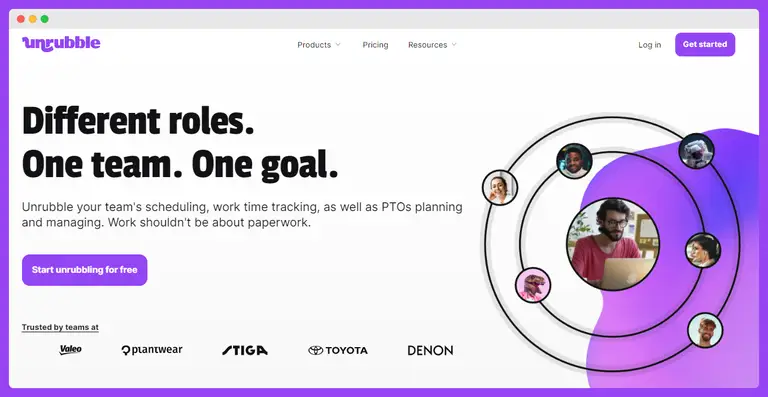Have you ever wondered about shaking up the regular 9-to-5 routine?
The 4/10 work schedule might just be the game-changer you're looking for.
This schedule has employees working four days a week, and for a solid ten hours each day.
As a manager or business owner, you're probably curious about how this could impact your team and your company.
In this article, we're going to break down what the 4/10 schedule is all about, talk about the good stuff, the challenges, and even share some real-world examples.
What is a 4/10 compressed work schedule?

A 4/10 compressed schedule is a type of schedule where employees work four days a week, each day consisting of a 10-hour shift. In this arrangement, employees typically enjoy an additional day off each week, contributing to a better work-life balance.
Instead of the traditional five-day workweek, employees on a 4/10 schedule complete their required hours by extending their daily working hours.
This alternative work schedule may offer benefits such as a longer weekend, increased flexibility, and reduced commuting time for employees.
However, it's essential to note that the specific days per week worked may vary based on the employer's policies and the nature of the job.
Let's break down a practical example of a 4/10 compressed schedule:
Assuming the standard workweek is Monday to Friday:
Employee schedule:
- Monday: 8:00 AM to 6:00 PM (10 hrs)
- Tuesday: 8:00 AM to 6:00 PM (10 hrs)
- Wednesday: 8:00 AM to 6:00 PM (10 hrs)
- Thursday: 8:00 AM to 6:00 PM (10 hrs)
Total hours worked: 40 hours
Days off: Friday, Saturday, and Sunday
What are the pros and cons of the 4/10 schedule?
Like any other schedule, this one has both advantages and disadvantages.
Let's have a look at the positives first.
Work 10 hours, enjoy longer weekends
People work four days a week, each consisting of a 10-hour shift. This means they fulfill their weekly hours in four days, providing a three-day weekend.
Reduced commuting
With one less day of commuting, employees may experience time and cost savings.
Flexibility
The schedule allows for an extra day off each week, providing flexibility for personal appointments or other commitments.
Employee productivity
Longer workdays might enhance focus and productivity as employees have fewer transition periods in and out of work mode each week.
And now, onto the disadvantages:
Extended workdays
Working for 10 hours a day may lead to fatigue and reduced energy levels, especially towards the end of the workday.
Limited outside-of-work time
Longer workdays may leave employees with limited time for personal activities, family, or social engagements on workdays.
Schedule rigidity
The schedule doesn't suit everyone, and some employees may find it challenging to adapt to the fixed four-day workweek.
Communication challenges
If employees on a 4/10 schedule are out on their extra day off, it may lead to potential communication gaps on that day.
In general, while a 4/10 schedule offers advantages such as extended weekends and reduced commuting, it comes with challenges like longer workdays and potential difficulties in maintaining work-life balance.
Which industries use the 4/10 schedule?
The 4/10 schedule is utilized across various industries to enhance operational efficiency. Here are examples of industries and sample schedules:
Manufacturing
In manufacturing, the 4/10 schedule can lead to increased productivity as longer shifts allow for sustained focus on tasks. The three-day weekend not only reduces commute stress but also gives employees extended periods to recover and return to work refreshed. The outcome? Reduced absenteeism.
Unique benefit - enhanced focus during the extended hours may lead to better quality outputs and efficiency in assembly lines.

Healthcare
The healthcare sector benefits from the 4/10 schedule as it minimizes the number of shift changes. As such, it ensures continuity of patient care. The longer shifts accommodate the demanding nature of healthcare work, and employees can enjoy a substantial break to recharge.
Unique benefit - longer shifts mean fewer handovers between staff. This way, the risk of communication errors is lowered and patient safety is improved.
Office jobs
Offices adopting the 4/10 schedule witness improved employee morale and job satisfaction. The extra day off allows for better work-life balance, reduced burnout, and increased overall job happiness.
Unique benefit - longer workdays foster team bonding during extended collaborative periods, potentially boosting creativity and innovation.

Construction
In construction, the 4/10 schedule aligns with daylight hours, maximizing operational efficiency. Workers get a three-day weekend. This setup promotes mental and physical recovery, as well as leads to increased job satisfaction and loyalty.
Unique benefit - the extended weekend allows for personal projects or additional training, contributing to skill development among construction workers.
Customer service
Customer service representatives benefit from the 4/10 schedule by having longer periods for focused customer interactions. The schedule flexibility can accommodate peak service hours. And why is it good? Workers get to improve overall customer satisfaction.
Unique benefit - employees can schedule personal appointments and activities on their extra day off. Thanks to that, they get to reduce the stress associated with balancing work and personal commitments.

Technology sector
In the tech sector, the 4/10 schedule fosters a culture of deep work, enabling developers and teams to immerse themselves in complex projects without frequent interruptions. The extended weekend provides an opportunity for self-directed learning and experimentation.
Unique benefit - the longer workdays align with the natural ebb and flow of creativity. Tech professionals can achieve a state of "flow" in their work.
Government offices
Government offices adopting the 4/10 schedule experience improved service delivery and responsiveness. The longer workdays lead to more efficient handling of administrative tasks. What's more, the extended weekend enhances employee well-being.
Unique benefit - citizens benefit from having more continuous service hours during the workday. This potentially reduces wait times and improves overall satisfaction with government services.

Alternative work schedules
The 4/10 pattern, while very popular, isn't the only working schedule that companies practice.
Check out these other schedules and how they differ from the 4/10 one:
9/80 Schedule
In a 9/80 schedule, workers work 80 hours over nine days within a two-week period. This typically involves eight 9-hour days and one 8-hour day, with an extra day off every other week.
How it differs from a 4/10: while both aim to provide extended weekends, the structures differ in the distribution of hours and the frequency of days off.
Flextime
Flextime allows employees to vary their start and end times within certain limits. It provides autonomy to adapt work hours to personal preferences, accommodating diverse lifestyles.
How it differs from a 4/10: flextime focuses on daily variations, accommodating individual preferences on a day-to-day basis, whereas the 4/10 schedule provides consistent longer weekends.
Telecommuting / remote work
With advancements in technology, many jobs can be performed remotely. Telecommuting allows employees to work from home or any location outside the traditional office.
How it differs from a 4/10: remote work emphasizes flexibility in work location, while the 4/10 schedule emphasizes fewer workdays for a specific period.
Compressed workweek (5/4/9)
Employees work four 9-hour days and have one day off every other week. This schedule extends the workday but provides a day off during the traditional workweek.
How it differs from a 4/10: both aim to extend weekends but differ in the number of hours worked per day and the specific days off.
Job sharing
Job sharing involves two part-time employees sharing the responsibilities of a full-time position. Each person works a portion of the week or month.
How it differs from a 4/10: job sharing is a collaborative approach, while the 4/10 schedule is an individual schedule designed for longer weekends.
How to use the 4/10 schedule

If the appeal of a 4/10 work schedule, featuring 10-hour workdays within a compressed schedule, has caught your attention, integrating it into your company requires thoughtful planning and execution.
Here's a step-by-step guide to help you make a seamless transition:
Assess feasibility
Before diving in, conduct a thorough feasibility analysis. Consider the nature of your business, employee roles, and client expectations. Make sure that the 4/10 schedule aligns with the operational requirements and won't adversely impact productivity or the traditional 9-5 schedule outside of work.
Communicate with employees
Open and transparent communication is key. Discuss the proposed 4/10 schedule with your employees, addressing any concerns they may have. Clearly articulate the benefits, including potential advantages and disadvantages. This will foster a collaborative atmosphere where input is valued.
Adjust schedules
Work with your team to establish a schedule that accommodates both business needs and employee preferences. Try to balance the advantages of compressed workdays with potential challenges outside of working times.
Pay attention to whether the distribution of work times and days off is conducive to maintaining efficiency and meeting deadlines.
Provide training
Offer training sessions to help employees manage the longer 10-hour workdays effectively. This could include time management strategies, team productivity tools, and techniques for maintaining a healthy work-life balance within the new schedule.
Implement flexibility
Recognize that one size does not fit all. Introduce flexibility within the 4/10 framework where possible. For instance, consider staggered start times or varying the days off for different teams. Tailoring the schedule to meet diverse needs is important.
Monitor and adjust
Regularly assess the impact of the 4/10 schedule on both productivity and employee well-being. Stay open to feedback, and be willing to make adjustments as needed. Consider potential impacts on work days and work-life balance. Flexibility in monitoring and refining the schedule ensures its long-term success.
How can you do it? By implementing time tracking.

Unrubble is the ideal solution for managing 4/10 work schedules. It simplifies scheduling, time tracking, and PTO planning. With precise time tracking, efficient scheduling tools, and integrated reporting, Unrubble takes the hassle out of managing work hours.
The platform integrates seamlessly with popular payroll systems and offers a user-friendly mobile time clock.
Employees can easily track their time using web or mobile apps. Unrubble also keeps teams informed with a free employee self-service app.
How we support 4/10 work schedule companies:
- employee scheduling - streamline teamwork thanks to easy scheduling
- time tracking - monitor work hours with precision
- PTO tracking & managing - engage with hassle-free tracking and handling of time-off requests
- timesheets for easy payroll - simplify payroll tasks
- an employee self-service app - provide easy access to information with our employee app
- a mobile time clock - clock in and out with accuracy and flexibility
Join over 149,950 happy users who love Unrubble's simplicity and transparency. It's the perfect fit for various needs, making work about the job, not paperwork.
Try it today for free.
Evaluate time tracking data
Leverage time tracking tools like Unrubble to gather data on employee performance and project timelines during these workdays. Evaluate this data to gain insights into the effectiveness of the 4/10 schedule. Adjustments can be made based on real-time information to optimize results.
Celebrate success and address challenges
Acknowledge and celebrate the positive outcomes of the new schedule, whether they are improvements in employee satisfaction, productivity gains, or other achievements. Simultaneously, address any challenges promptly, demonstrating a commitment to continuous improvement.
Schedule the right times for your employees - can a 4-day workweek work?
Now you know everything about the 4/10 work schedule.
Generally speaking, a four 10-hour day workweek can function for many organizations, and it has gained popularity as a flexible scheduling option.
However, keep in mind its success depends on the nature of the business, employee roles, and effective communication and management of the new schedule.
It may not be suitable for all industries or positions.
As such, you need careful consideration to ensure that it aligns with the specific needs and goals of your organization.
If you do end up incorporating it into your company, don't forget to use Unrubble for a far smoother experience.
FAQ
What does 4x10 mean in work?
A 4x10 work schedule means employees work four days a week, each day for 10 hours. This compressed schedule involves longer daily hours but fewer days each week.
Is 4:10 a good schedule?
A 4:10 schedule can be a good alternative work schedule for many, as it provides employees with an extra day off each week, which saves employees time and can reduce employee stress.
What is a 4 person 10-hour shift schedule?
In a 4 person 10-hour shift schedule, employees work in teams of four, each working 10 hours per day, allowing full coverage with a four day workweek, often utilized in continuous operations without interrupting service or production.
What is the difference between 9 80 and 4 10?
The difference between a 9/80 and a 4/10 schedule is that in a 9/80 schedule, employees work nine hour days over two weeks, accumulating 80 hours across nine days, whereas in a 4/10 schedule, employees work four days of ten hours each week.
Is 3/12 hour shift worth it?
A 3/12 hour shift can be worth it for those who prefer working fewer, longer days. It allows for a more condensed workweek and longer consecutive days off, though it may require careful management of overtime pay.
Are 10 hour shifts too long?
10 hour shifts may be too long for some, as the extra hours each day can increase fatigue and stress. It depends on the individual's capacity and the nature of their job.
Is it better to work 4 10 or 5 8?
Whether it's better to work 4 10-hour days or 5 eight-hour days often depends on personal preference and lifestyle needs. A 4/10 schedule offers longer weekends and can reduce commuting costs, while a traditional schedule may better suit those who prefer spreading their work hours across more days with shorter hours.
How to survive a 10 hour shift?
To survive a 10-hour shift, it’s important to take regular breaks, stay hydrated, maintain a healthy diet, and use workforce management software to schedule employees efficiently. Flexibility in start times and breaks can also help manage the demands of longer work hours.








